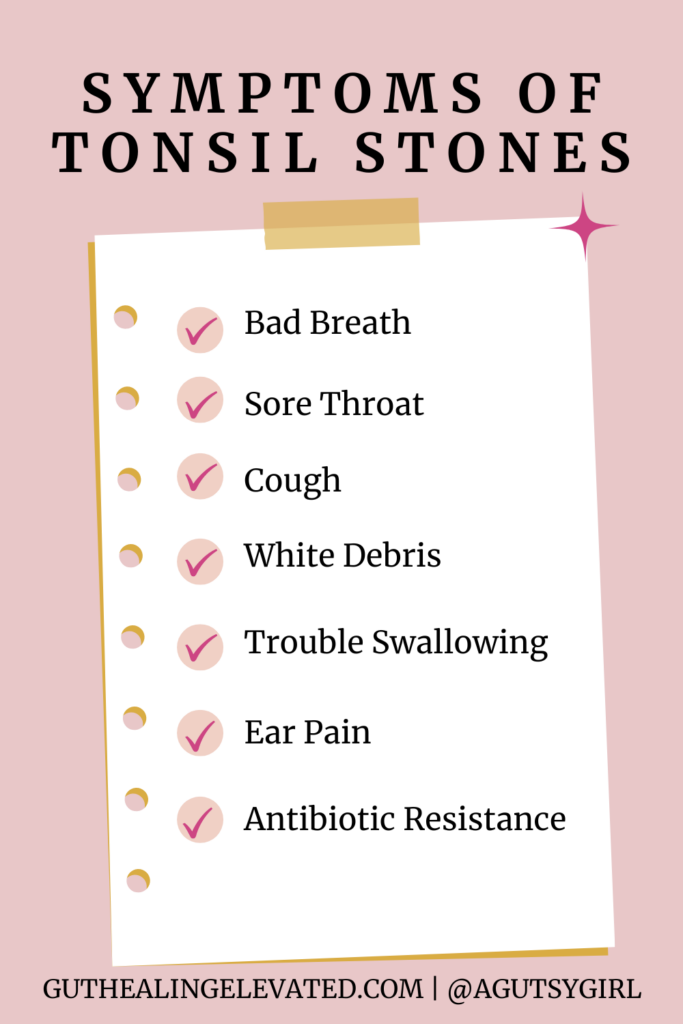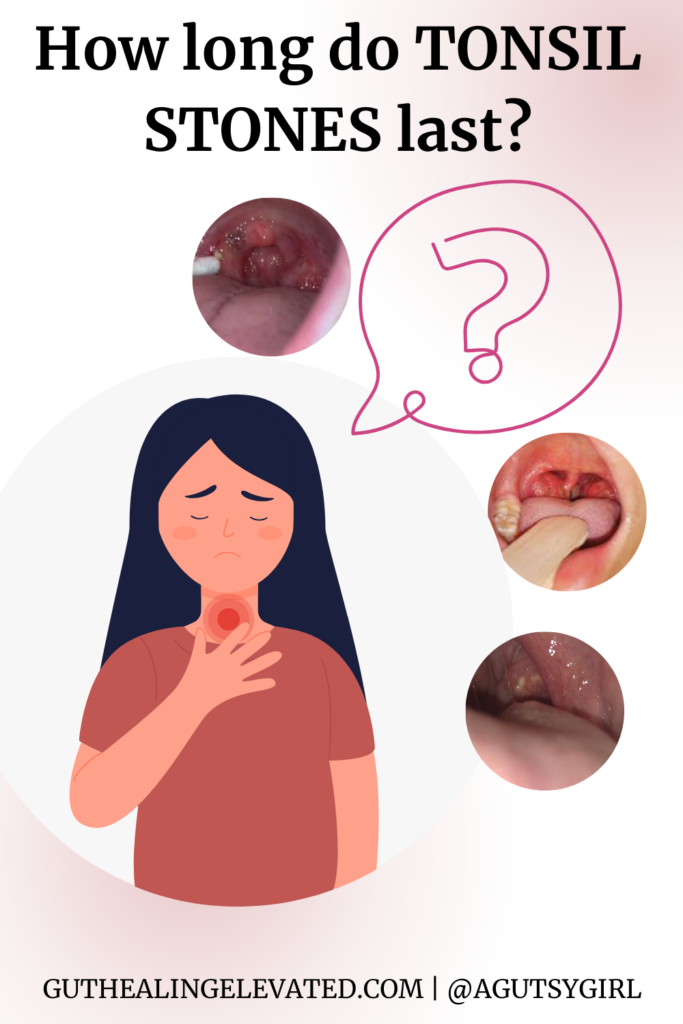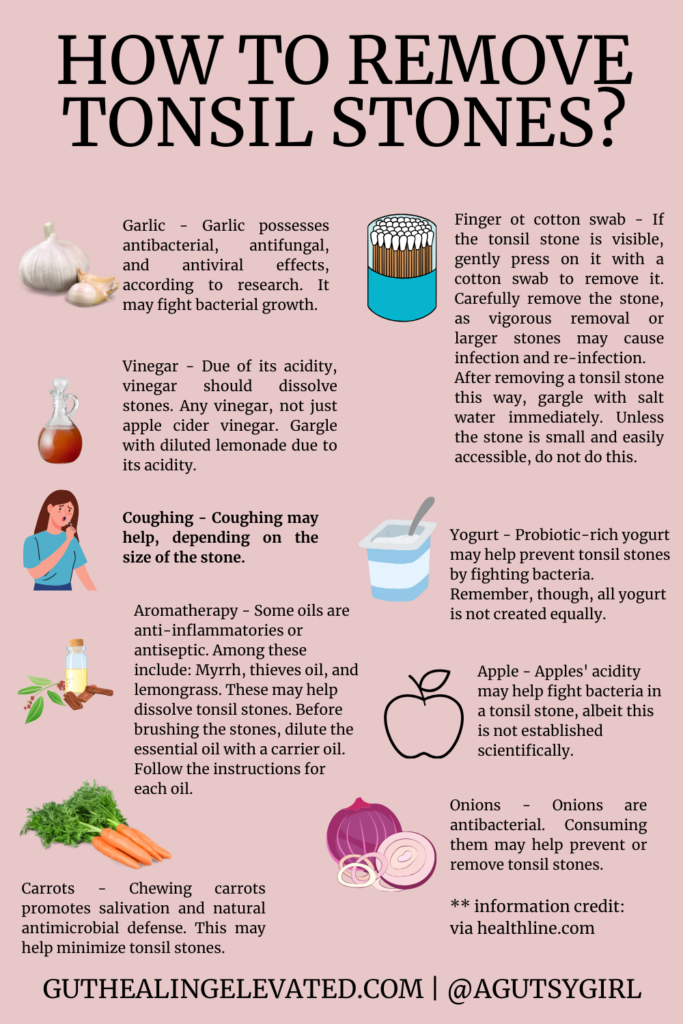What does it mean when you see white spots on your tonsils? And what are some home remedies for white spots on tonsils?
I was inspired to write this post after chatting all things gut with Ben Leber on his podcast.
As we were talking through my story, we started talking about the chronic tonsillitis, strep, and pharyngitis that plagued me for years.
During that time, I was constantly spitting up these tiny, little boogery white balls that were coming from my back of the throat.
I told him they are known as, “Tonsil stones.”
It was a whole discussion, and you can hear more about it here.
“Anyways,” I told him, “after I had my tonsils removed, I never spit up another ball of the nasties. (Yeah, even on Ben Leber’s podcast, I’m not afraid to tell it like it is 🙂 )
Home Remedies for White Spots on Tonsils
Click HERE to save this post for later.

Let’s back up for just a minute.
This is a gut health website, so why am I sharing a ton of information about tonsil stones and the tonsils in general today?
Because this was one of my very first, non-gut, main symptoms.
You might find yourself in these same shoes today so I want to give some context around it all in case it helps you uncover even more for your own journey.
(Reason number 8,765 why you should be keeping a meticulous gut healing journey journal.)
White Spots on Throat
Infection might show up as white patches in the back of your throat or on your tonsils causing throat pain.
These areas are usually unpleasant or painful, and the pain can be exacerbated by swallowing or coming into touch with acidic foods.
These white patches can be the result of damage from chemical exposures, in addition to illness. (Note: I believe all my throat issues were made far worse because, during that time, I also worked in the Fragrance department at – what was then called, “Marshall Fields.”)
Anyways, I digress – back to it……
While throat white patches may be accompanied by other symptoms such as a sore throat or a runny nose or a fever, they are most often the result of a more serious illness.
Streptococcus bacteria – ie. strep throat is a common strep bacteria illness that can create white patches on the throat.
Streptococcus bacteria are responsible for the infection. Infection with strep throat is a common and contagious sickness that manifests as a tender and painful sore throat followed by fever and other signs and symptoms. In a similar vein, infectious mononucleosis is a common viral infection that can manifest itself as white patches on the throat.
Adenoids
In addition to the tonsils are the adenoids.
Tonsils are the two round lumps in the back of your throat. Adenoids are high in the throat behind the nose and the roof of the mouth (referred to as your soft palate). source
The adenoids are small but mighty, and they typically only present problems in early childhood. (They begin to shrink around age 5 to 7 in children, and can be almost completely gone by the teenage years. source)
What Are Tonsil Stones?
Now that we know what the tonsils and adenoids are, let’s talk about the tonsil stones, which is why we are here to begin with today and where this conversation originated from.
Tonsil stones, also known as tonsilloliths, are made up of hard, painful germs and debris which become lodged in nooks on your tonsils.
These nooks are referred to as “crypts.”
Cryptic Tonsils
Tonsillar crypts are pockets or folds that occur naturally in tonsils, which are lumps of soft tissue on each side of the throat that are part of the immune system.
Adult tonsils have 10-20 crypts. Tonsil crypts are lines in the tonsils where two fold edges meet.
Tonsil crypts are usually small and clean. If food, mucus, or other debris gets lodged in them, it can harden into tonsil stones, or tonsilloliths.
Source: HERE
Personal experience: My tonsil crypts were not small and clean. They were large, visible, and as the doctor who performed my tonsillectomy and adenoidectomy (yes, I had them both removed) stated, “So scarred the tonsils and adenoids were barely visible anymore.”
Tonsil Stone Causes
When bacteria and other foreign objects, such as dead cells and mucus become lodged together in those crypts, debris has the potential to link together.
Tonsil stones form as a result of the hardening or calcification of this debris.
Individuals who have had long-term inflammation in their tonsils or who have had recurrent bouts of tonsillitis are more likely to develop this condition.
There are many individuals who have little tonsilloliths, but only in rare cases are huge tonsil stones present.
Symptoms of Tonsil Stones
Click HERE to save these symptoms for later.

After hearing me talk about it on Ben’s podcast, you can see how it’s very apparent if you have them.
They. are. disgusting.
I had an awful taste in my mouth and could physically see + smell them when they came out of my mouth.
However, that was my experience. But the presence of little tonsil stones may not be accompanied by any symptoms that you would notice.
So, here are 7 signs and symptoms:
Bad Breath
Bad breath is one of the most common symptoms of a tonsil infections and inflammation of the tonsils.
Patients with a long-term form of tonsillitis were tested for volatile sulfur compounds, which can cause bad breath, in conducted research.
More than 75% of those with abnormally high levels of these chemicals also had tonsil stones, according to the study results.
Sore Throat
Tonsillitis and tonsil stones can cause a lot of pain and a severe sore throat at the same time.
In addition to the generalized sore throat symptoms, tongue soreness or discomfort may be caused by the tonsil stone itself.
Cough
It is possible that a stone will irritate your throat and cause you to cough.
White Debris
In the back of your throat, you may be able to see a solid white lump of substance that is a tonsil stone.
Trouble swallowing
If you have a tonsil stone, swallowing food or liquids may be difficult or unpleasant depending on where it is located and how big it is.
Ear Pain
They can form anywhere in your tonsil. Because common neutral pathways exist, you may feel pain in your ear even though the stone isn’t there.
Antibiotic Resistance
When medical attention is needed, your healthcare provider is likely to prescribe an antibiotic to address the bacterial infection.
However, your throat infections may become harder to treat with a course of antibiotics.
** I will add that in addition to the above, I also had a nasal-sounding voice and nasal congestion, but this was likely do to the chronic tonsillitis and pharyngitis and enlargement of the tonsils prior to their removal.
Source: HERE
How long do tonsil stones last?

Tonsil stones can disintegrate or detach on their own.
However, they can also persist for weeks if bacteria grows on the tonsils due to the throat stones.
And then (like in my case), they can remain for years if overlooked and not treated.
The only approach to heal tonsil stones and avoid recurrence is to remove them.
How to remove tonsil stones
Note: I NEVER tried any of the natural tactics below. The reason is not that I don’t think they can work. Instead, I had them long before I ever knew my body the way I do today; long before I’d ever give an alternative healing method a chance. I was not seeking out these solutions. You, however, do have the chance.
Natural remedies may work if your tonsil stones are little.
According to Healthline, here are 9:
** Most natural therapies only work on minor tonsil stones or help avoid them.
Garlic
Garlic possesses antibacterial properties, antifungal, and antiviral effects, according to research. It may fight bacterial growth.
Note: Regardless of whether or not you have tonsil stones, I think that eating garlic is a good idea for overall health. I eat 1-3 whole, pickled garlic cloves per day, especially during the peak of cold and flue season.
Vinegar
Due of its acidity, vinegar should dissolve stones. Any vinegar, not just apple cider vinegar. Gargle with diluted warm liquids due to its acidity.
Finger or cotton swab
If the tonsil stone is visible, gently press on it with a cotton swab to remove it. Carefully remove the stone, as vigorous removal or larger stones may cause infection and re-infection.
After removing a tonsil stone this way, gargle with a teaspoon of salt water immediately. Unless the stone is small and easily accessible, do not do this.
Coughing
Coughing may help, depending on the size of the stone. If you’re already sick, this is something that might naturally occur. And I think this is one reason why I would have so many suddenly come “out.”
Aromatherapy
Some oils are anti-inflammatories or antiseptic. Among these include: Myrrh, thieves oil, and lemongrass. These may help dissolve tonsil stones. Before brushing the stones, dilute the essential oil with a carrier oil. Follow the instructions for each oil.
Yogurt
Probiotic-rich yogurt may help prevent tonsil stones by fighting bacteria.
Remember, though, all yogurt is not created equally.
Apples
Apples’ acidity may help fight bacteria in a tonsil stone, albeit this is not established scientifically.
However, when the tonsil stones become that problematic in your life, you might try anything 🙂
Carrots
Chewing carrots promotes salivation and natural antimicrobial defense. This may help minimize tonsil stones.
Onions
Onions are antibacterial. Consuming them may help prevent or remove tonsil stones.
Click HERE to save these natural remedies.

Other At Home Treatment Options
In addition to the at-home remedies Healthline presents, here are some other things I did:
- Simply gargle with warm salt water. Because I was constantly struggling with tonsillitis and pharyngitis, I did this to try to soothe the throat and help remove bacteria.
- Try oil pulling. Coconut oil helps support the immune system as it contains anti-microbial lipids, lauric acid, capric acid and caprylic acid which have anti-fungal, antibacterial and antiviral properties. Oil pulling is simply swishing oil around in your mouth for an extended period of time. Proponents of it say that it helps clear bacteria from the mouth, which could help with bacterial infections.
- Drink warm beverages. To help loosen up the bacteria and also find soothing relief, opt for things like warm herbal teas and bone broth. Even warm water with a little raw honey and fresh-squeezed lemon juice can help, if you want to keep it super simple.
- Consider propolis spray. According to Beekeeper’s Naturals, “Propolis is the defender of the hive. Bees use it to line the walls and keep germs out. We use it to support our immune systems, soothe dry, scratchy throats, combat free radical damage in the body, and feed the good bacteria in our gut.” Throat sprays are easy to use, and people often have a lot of success with them as both a precautionary and to help reduce symptoms.
- Use high-quality throat lozenges. These are generally helpful simply to soothe your throat and help give pain relief. Just make sure you’re finding a high-quality lozenge that contains other healing ingredients like vitamin c, elderberry, lemon, honey, propolis, zinc, etc. Avoid the ones that contain artificial sweeteners and other ingredients.
How Else Can I Get Rid of Tonsil Stones?
So if the natural remedies won’t work, then what? First, make sure you are receiving some sort of medical treatment. Sometimes we need medical help when all the at-home remedies simply aren’t working. I sure did!
There are two main options:
Antibiotics
Antibiotics can help treat tonsil stones in some circumstances. They can help reduce bacteria counts that contribute to the formation of tonsil stones.
However, don’t forget that:
- Antibiotics have the disadvantage of not treating the underlying cause of the stones and having potential adverse effects.
- Since antibiotics are not intended to be used long term, the tonsil stones will likely recur after stopping them.
Tonsillectomy
A Tonsillectomy means tonsil removal. This can be done with a scalpel, laser, or coblation (a word derived from “controlled ablation” involves using low-temperature radio frequency and a saline solution to gently and precisely remove the problematic tissues) device.
A tonsillectomy for tonsil stones is usually recommended only in severe situations and after all other options have failed. Again, this was me!
While having your tonsils removed is not ideal due to the important role they play in overall immune function, sometimes situations warrant it.
Source: HERE
Research shows that tonsil removal patients are no more susceptible to bacterial or viral infections than those who keep their tonsils.
My experience both proved that right and wrong.
Since the removal, I can count the number of times my throat has been affected. And the good news is that it was never as sever and furthermore I never got tonsil stones again.
However, because I had my tonsil out when I was a Senior in college, I didn’t change anything about the way I was living at the time. Therefore, illness manifested in different ways and areas of my body.
You must know these facts.
Why Does This All Matter?
Okay, so let’s bring this altogether now.
Why do tonsils, adenoids, and the fact that I started noticing so many of those little, nasty tonsil stone creeping up in my life matter?
It’s all going to go back to the immune system.
And remember, somewhere between 60-80% of the immune system is located in the gut.
Tonsils and adenoids are part of the immune system, similar to lymph nodes. They are the body’s first line of defense and help protect the body from disease.
Many scientists believe tonsils are supposed to act like nets, capturing bacteria and viruses that enter through the throat.
Sources: HERE
But your tonsils aren’t always reliable. They’re more trouble than help for some. And by “some,” I’m talking about me, too.
They were a massive problem for me.
Let’s consider that my gut issues likely started and triggered with my insane dieting during high school. I mean, that wasn’t really a trigger, it just set up the perfect environment for later disaster.
Then, if you remember, I was super stressed after a miserable breakup at the beginning of my Freshman year of college. So, the base became even more sturdy for disaster.
And then, I came down with that “mysterious illness” that left me down and out for a couple weeks.
I was never the same.
My gut was not great going into that illness, but I just didn’t know it yet. The perfect storm was waiting to arrive; I simply didn’t know my body well enough or how the body works at all.
Anyways, if much of the immune system lies within the gut and the tonsils and adenoids are part of this system, then this scenario starts to make perfect sense.
Wrap Up
My point in all of this is that those white spots on tonsils, weird booger-like balls that pop up, chronic throat infections, and bacterial illness that won’t leave with antibiotics are another sign that your gut is off.
If you’ve been keeping a meticulous journal, go back through it and see if any of this has been present.
Don’t put the issues aside as, “just a mouth problem.”
It’s far from it.
If you liked this post on home remedies for white spots on tonsils you might also enjoy:
- Chronic Illness Root Cause Analysis
- Food Intolerance or a Leaky Gut
- Fight a Virus by Protecting Your Gut
Xox,
SKH






